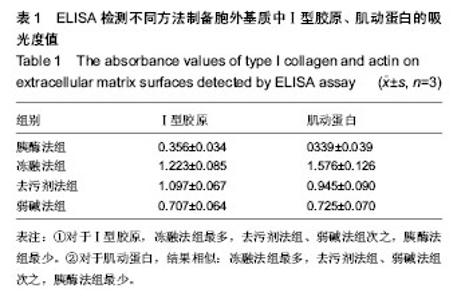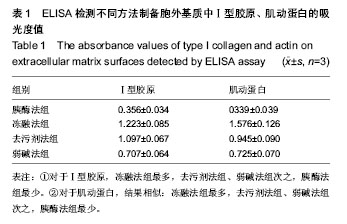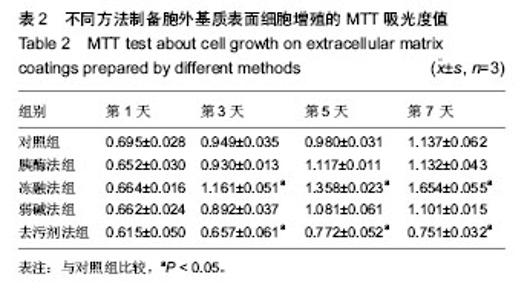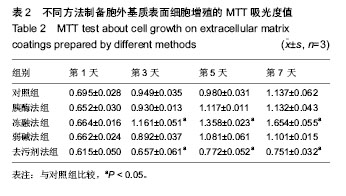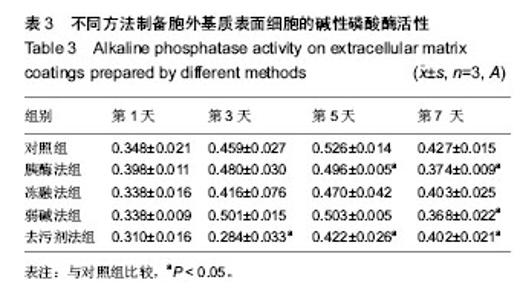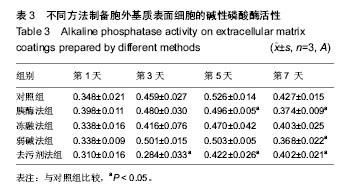| [1] Morra M. Biochemical Modification of titanium surfaces: peptide and ECM proteins. Eur Cell Mater.2006;12:1-15.
[2] Kim S,Myung WC,Lee JS,et al.The effect of fibronectin-coated implant on canine osseointegration.J Periodontal Implant Sci.2011;41(5):242-247.
[3] Lamberg A,Schmidmaier G,Soballe K.Locally delivered TGF-beta1 and IGF-1 enhance the fixation of titanium implants: a study in dogs.Acta Orthopaedica.2006;77(5): 799-805.
[4] Hennessy KM,Pollot BE,Clem WC,et al.The effect of collagen I mimetic peptides on mesenchymal stem cell adhesion and differentiation, and on bone formation at hydroxyapatite surfaces.Biomaterials.2009;30(10):1898-1909.
[5] Culpepper BK,Bonvallet PP,ReddyM S,et al.Polyglutamate directed coupling of bioactive peptides for the delivery of osteoinductive signals on allograft bone. Biomaterials. 2013; 34(5):1506-1513.
[6] Shekaran A,García AJ.Extracellular matrix-mimetic adhesive biomaterials for bone repair.J Biomed Mater Res A. 2011; 96(1):261-272.
[7] Baas J,Jakobsen T,Elmengaard B,et al.The effect of adding an equine bone matrix protein lyophilisate on fixation and osseointegration of HA-coated Ti implants. J Biomed Mater Res A.2012;100(1):188-194.
[8] 毛晶晶,何家才,郑先雨,等.富血小板纤维蛋白在犬上颌窦底提升中促骨缺损修复的作用[J].安徽医科大学学报, 2010,45(2): 176-179
[9] 孔丽,唐旭炎,李全利.新型纳米复合材料对犬下颌牙槽骨缺损的修复效果[J].安徽医科大学学报,2011,46(12):1245-1248.
[10] 周允芝,唐旭炎,宁天云,等.类釉原蛋白寡肽仿生修饰钛表面的研究[J].安徽医科大学学报,2013,48(2):124-127.
[11] 杨全全,何家才,杨瑞,等.富血小板纤维蛋白修复牙种植体周围骨缺损的研究[J].安徽医科大学学报,2012,47(5):581-584.
[12] 陈永吉,曾宪涛,解龙川,等.异种脱细胞真皮基质在牙种植术中的临床应用[J].临床口腔医学杂志,2011,27(4):240-242.
[13] 邹嘉平,杨契超.异种脱细胞真皮基质修复膜修复鼓膜穿孔的临床应用[J].南京医科大学学报:自然科学版, 2011,31(1):94-95, 122.
[14] 刘广毅,杨军成.脱细胞异体真皮基质修复口腔组织缺损的疗效观察[J].四川医学,2012,33(7):1206-1207.
[15] 张毓姣,沈国良,林伟,等.异种脱细胞真皮基质与薄自体皮复合移植用于深度烧伤创面治疗[J].浙江临床医学, 2012,14(12): 1519-1520.
[16] 余勇,赵慧,许瑾,等.脱细胞异体真皮支架与自体皮片复合移植的临床应用[J].蚌埠医学院学报,2012,37(10):1189-1190.
[17] 刘立强,马莲.异种脱细胞真皮基质用于牙槽嵴裂植骨术的效果观察[J].北京口腔医学,2012,20(6):338-340.
[18] 王乾锋,刘宏伟.脱细胞真皮基质作为GTR屏障膜治疗Ⅱ度根分叉缺损的实验研究[J].口腔颌面外科杂志, 2013,23(5): 347-351.
[19] 周瑜,叶茂昌,李容新,等.应用改良型异种脱细胞真皮基质修复重建小型舌鳞癌切除术后缺损[J].中国口腔颌面外科杂志, 2014, 12(1):56-60.
[20] 王永前,李森恺.脱细胞膀胱黏膜下基质异种移植的实验研究[J].军事医学,2013,37(9):696-699.
[21] 韦殿闯.磨痂术联合DR脱细胞异种皮移植术在四肢深Ⅱ度烧伤创面的运用[J].广西医科大学学报,2013,30(5):793-794.
[22] Datta N,Pham QP,Sharma U,et al.In vitro generated extracellularmatrix and fluid shear stress synergistically enhance 3D osteoblastic differentiation.Proc Natl Acad Sci U S A.2006;103(8):2488-2493.
[23] Pham QP,Kasper FK,Scott BL,et al.The influence of an in vitro generated bone-like extracellular matrix on osteoblastic gene expression of marrow stromal cells. Biomaterials. 2008; 29(18): 2729-2739.
[24] 范利梅,唐旭炎,李全利,等.骨髓基质细胞在胞外基质涂层钛表面的黏附和铺展[J].中国组织工程研究与临床康复, 2009,13(21): 4029-4032.
[25] 范利梅,唐旭炎,李全利,等.钛表面胞外基质涂层对骨髓基质细胞增值和分化的影响[J].安徽医科大学学报, 2009,44(5): 551-553.
[26] Thibault RA,Scott Baggett L,Mikos AG,et al.Osteogenic differentiation of mesenchymal stem cells on pregenerated extrcellular matrix scaffolds in the absence uf osteogenic cell culture supplements.Tissue Eng A.2010;16(2)431-440.
[27] Decaris ML,Mojadedi A,Bhat A,et al.Transferable cell-secreted extracellular matrices enhance osteogenic differentiation.Acta Biomater.2012;8(2):744-752.
[28] Decaris ML,Leach JK.Design of experiments approach to engineer cell-secreted matrices for direcring osteogenic differentiation.Ann Biomed Eng.2011;39(4):1174-1185.
[29] Prewitz MC,Seib FP,von Bonin M,et al.Tightly anchored tissue-mimetic matrices as instructive stem cell microenviroments.Nat Methods.2013;10(8):788-794.
[30] 孙亨,王艳霞,吴江.组织脱细胞方法的研究进展[J].四川解剖学杂志,2011,19(4):24-30.
[31] 陈博,彭代智.组织和器官脱细胞方法的研究进展[J].中华损伤与修复杂志:电子版, 2012,7(6):58-63.
[32] 赵宇,于淼,柏树令.脱细胞技术及其在组织工程中的应用研究进展[J].中国修复重建外科杂志,2013,27(8):950-954.
[33] 张红霞,翟万银,张红锋.适用于不同尺寸血管的脱细胞方法研究[J].华东师范大学学报:自然科学版,2012,58(4):50-60.
[34] 阴洪,任先军,蒋涛.脱细胞技术在同种异体组织工程支架中的研究进展[J].中国矫形外科杂志,2012,20(11):1010-1012.
[35] 陈博,彭代智,左海斌,等.新生小牛皮肤的形态学和生物力学特点及脱细胞方法探索[J].重庆医学,2012,41(11):1043-1046,封2.
[36] 杨召,马信龙,李秀兰,等.不同脱细胞方法对周围神经生物力学性能的影响[J].中国生物医学工程学报,2011,30(1):155-159.
[37] 贾桦,王莹,佟雷,等.不同脱细胞方法制备的AECM成分分析及比较[J].牡丹江医学院学报,2013,34(4):1-4.
[38] 许海委,徐宝山,杨强,等.不同脱细胞方法对猪尾纤维环生物力学特性及组织结构的影响[J].医用生物力学, 2013,28(4): 448-453.
[39] 范雪梅,李胜平,徐惠成.交联剂对脱细胞膀胱基质生物力学性能的影响[J].北京生物医学工程,2013,32(4):370-374.
[40] 孙飞,潘枢,史宏灿,等.去污剂-联合酶法行兔脱细胞组织工程气管制备及性能评价[J].中华胸心血管外科杂志, 2014,30(1): 38-41,55.
[41] 唐孝明,万伦,刘仲前,等.改良组织块法大鼠成骨细胞培养的研究[J].四川医学,2004,25(5):45-45,245.
[42] 胡静,郑洪新.改良成骨细胞体外培养和鉴定方法[J].中国老年学杂志,2006,26(1):76-78.
[43] 李晓峰,赵劲民,苏伟,等.大鼠成骨细胞的原代培养和鉴定[J].中国组织工程研究与临床康复,2011,15(6):990-994.
[44] 王双利,查振刚,刘宁,等.改进酶消化法培养SD大鼠成骨细胞及其鉴定[J].实用医学杂志,2008,24(6):915-918.
[45] 程浩,张延芳,许巍.新生大鼠成骨细胞原代培养与鉴定[J].中国组织工程研究,2013,17(41):7199-7204. |
